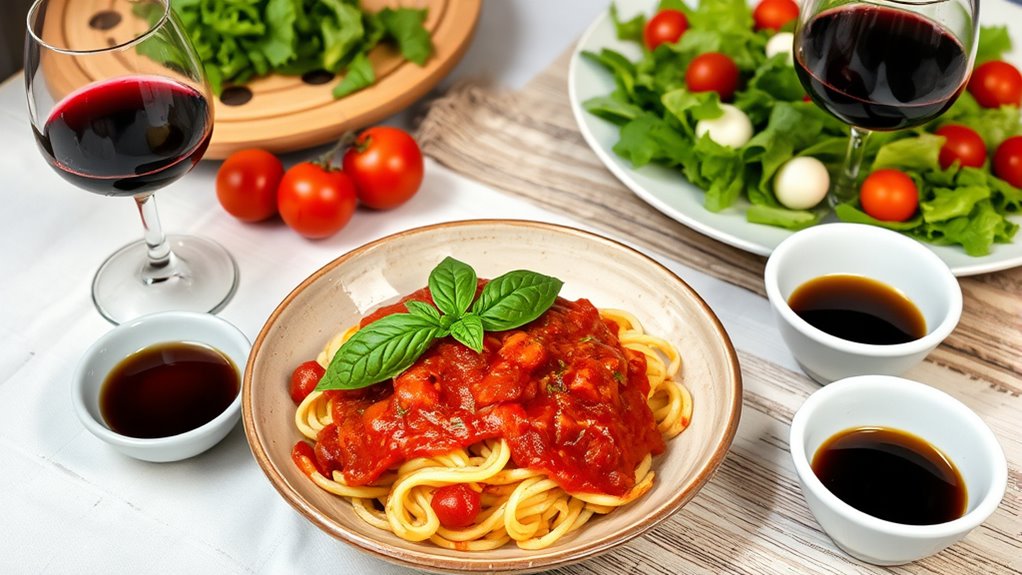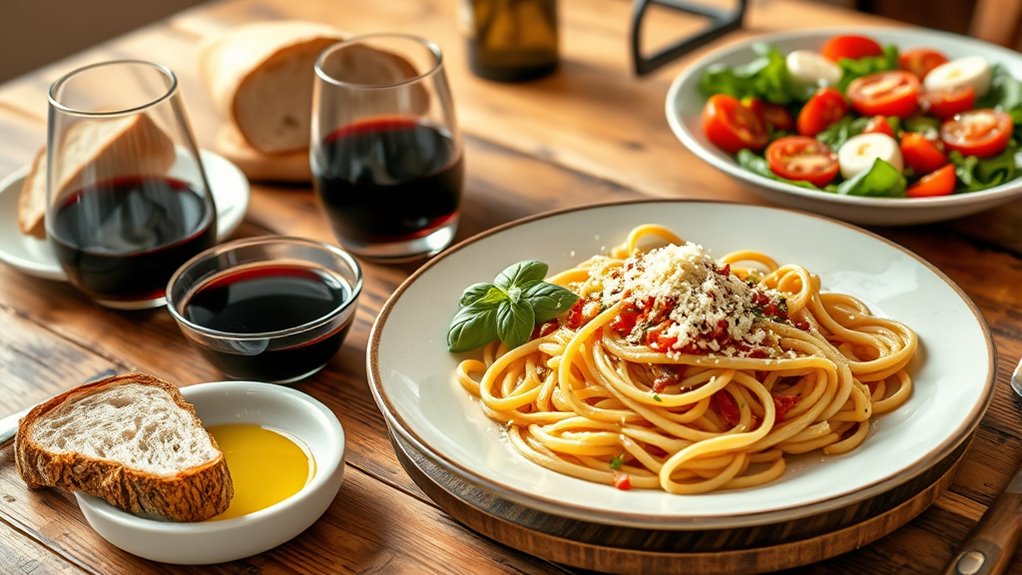In Italy, you’ll find modest portion sizes that focus on quality and balance, with regional differences shaping the servings. Meals follow a structured, multi-course format, starting with antipasti, then pasta or soup, followed by meat or fish, and ending with dessert and coffee—all served in controlled amounts to enhance enjoyment. The emphasis is on savoring each course without feeling overwhelmed. To understand more about Italy’s culinary traditions, keep exploring these fascinating details.
Key Takeaways
- Italian meals follow a structured, multi-course format emphasizing moderation and balance in each serving.
- Portion sizes are typically modest, focusing on quality and flavor rather than quantity.
- Regional differences influence portion sizes, with Northern Italy favoring lighter dishes and the South serving larger portions.
- Courses are served sequentially with careful presentation, allowing diners to savor flavors without feeling overwhelmed.
- Dessert and coffee are served in restrained portions, completing the meal harmoniously.

When exploring Italian cuisine, understanding their portion sizes and meal structure is essential to fully appreciating the dining experience. Italy’s culinary traditions vary considerably across regions, influencing both how much you’re served and how meals are organized. These regional culinary differences mean that a typical plate in northern Italy might differ from one in Sicily, not just in ingredients but also in portion sizes and serving styles. In general, Italians favor modest portions that highlight quality over quantity, allowing you to savor flavors without feeling overwhelmed. This approach is rooted in traditional serving methods, which emphasize balance and harmony among courses rather than filling up on a single dish.
In Italy, meals tend to follow a structured format that promotes a leisurely, multi-course experience. You might start with antipasti, such as cured meats, cheeses, or marinated vegetables, served in small, carefully curated portions. These are meant to stimulate your appetite without filling you up prematurely. Following this, the primo piatto, typically pasta, risotto, or soup, arrives in a portion that’s satisfying but not excessive. The emphasis remains on enjoying the dish for its flavors, rather than piling your plate high. Secondo, the main course of meat or fish, usually comes next, often accompanied by a modest side of vegetables or bread. Each course is served in smaller servings compared to what you might encounter elsewhere, reinforcing the Italian focus on quality and balance.
Additionally, the cost considerations of dining in Italy often influence portion sizes, as modest servings help manage expenses while maintaining tradition. Dessert and coffee mark the conclusion of a traditional Italian meal, often in similarly restrained portions. This structure encourages you to appreciate each component individually, rather than rushing through a large, heavy meal. Because of regional culinary differences, you’ll notice variations—Southern Italy might serve slightly larger portions of pasta or a richer dessert, while in the north, you may find lighter, more delicate dishes. Traditional serving methods also emphasize the importance of timing and presentation, making each course an experience to savor. Understanding these nuances helps you grasp why Italian meals feel more about quality, harmony, and tradition rather than quantity.
Frequently Asked Questions
How Do Italian Portion Sizes Compare to Other European Countries?
When comparing Italian portion sizes to other European countries, you’ll notice some differences in meal portion comparisons. Italian portions tend to be smaller, emphasizing quality over quantity, which can surprise you if you’re used to larger servings elsewhere. These portion size differences reflect Italy’s focus on balanced, flavorful meals with careful control. So, you’ll find that Italian meals are often more modest in size, promoting mindful eating and better portion management.
Are There Regional Variations in Italian Meal Structures?
You’ll find regional variations in Italian meal structures, shaped by regional culinary traditions and local ingredient influences. In some areas, meals start with antipasti and move to pasta or risotto, while others focus more on hearty meat dishes or seafood. These differences reflect local history, climate, and available ingredients, creating diverse dining experiences across Italy. Embracing these regional patterns helps you enjoy authentic Italian cuisine at its best.
What Are Typical Portion Sizes for Children in Italy?
You want to know typical portion sizes for children in Italy, which are usually smaller than adult servings. In Italy, child nutrition emphasizes portion control to promote healthy eating habits. Kids often receive age-appropriate portions that support growth without overeating. As a parent or caregiver, you should focus on balanced meals with the right portion sizes to help your child develop good eating habits and maintain a healthy weight.
How Does Italian Meal Timing Differ Across Regions?
You’ll find that regional dining customs in Italy influence meal timing, with each area having unique routines. For example, northern regions tend to have a later dinner, while southern areas often eat earlier. Regional breakfast habits also vary, with some places preferring a quick espresso and pastry, and others enjoying a more substantial meal. These differences reflect local traditions and cultural preferences across Italy’s diverse regions.
Do Traditional Italian Meals Include Dessert Every Day?
You might wonder if Italians eat dessert daily. Traditionally, dessert isn’t part of every meal, and daily sweet consumption isn’t a strict habit for most. Instead, Italians often enjoy a small sweet, like fruit or a pastry, a few times a week. This balanced approach keeps dessert special without making it an everyday occurrence, emphasizing quality over quantity in their meal structure.
Conclusion
Now that you understand Italian portion sizes and meal structure, you’ll appreciate how balance and tradition shape their dining habits. Did you know that Italians typically serve about 30% smaller portions than Americans? This helps promote moderation and enjoyment of each dish. By embracing their approach, you can savor authentic flavors without overeating. So, next time you dine Italian-style, remember that less can truly be more, making your meal both satisfying and healthy.









